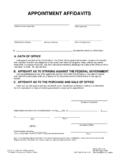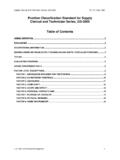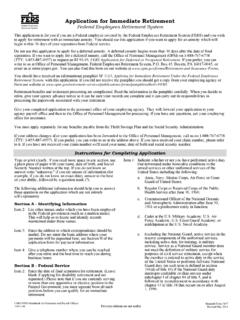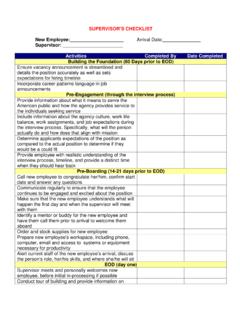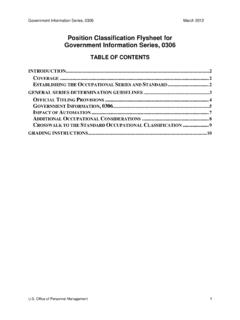Transcription of OPM Policy Guidance - OPM.gov
1 1 Original Issuance Date: December 8, 2009 Revision Date: June 23, 2015 Office of Personnel Management OPM Policy Guidance Regarding Reservist Differential under 5 5538 Table of Contents I. Overview II. Coverage A. Covered Agencies B. Covered Employees III. Qualifying Periods IV. Civilian Pay and Leave Status V. Projected Civilian Basic Pay A. Civilian Tour of Duty B. Basic Pay Adjustments C. Biweekly Total Civilian Basic Pay VI. Actual Military Pay and Allowances VII. Computation and Payment of Reservist Differential A. Comparison of Civilian and Military Compensation B. Adjustment for Paid Hours C. Payment D. Treatment for Tax Purposes E. Treatment for Purposes of Various Pay-Related Laws Appendices Appendix A Statutory Provision (5 5538) Appendix B Definitions Appendix C Civilian Basic Pay Appendix D Military Duty and Compensation Appendix E Example NOTE: See #url=Reservist-Differential for additional information.
2 See Chronological Summary of Changes at the end of this document for notes regarding changes made to the Guidance over time. 2 OPM Policy Guidance Regarding Reservist Differential under 5 5538 I. Overview This document provides Guidance to agencies on implementing a new law providing differential payments to eligible Federal civilian employees who are members of the Reserve or National Guard (hereafter referred to as reservists ) called or ordered to active duty under certain specified provisions of law. This new law is codified in 5 5538, which was added by section 751 of the Omnibus Appropriations Act, 2009 (Public Law 111-8, March 11, 2009), as amended by section 745 of the Consolidated Appropriations Act, 2010 (Public Law 111-117, December 16, 2009).
3 Section 5538 became effective on the first day of the first pay period beginning on or after March 11, 2009 ( , March 15, 2009, for executive branch employees on the standard biweekly payroll cycle). Pending issuance of regulations, agencies should follow this Guidance in applying section 5538, including retroactive application to the period between March 15 and the original issuance date of this Guidance (December 8, 2009). Under section 5538, Federal agencies must provide a payment hereafter referred to as a reservist differential equal to the amount by which an employee s projected civilian basic pay for a covered pay period exceeds the employee s actual military pay and allowances allocable to that pay period. The reservist differential is not payable for periods during which the employee is receiving civilian basic pay for performing work or using civilian paid leave or other paid time off.
4 (This requirement is accomplished by a special adjustment, as described in section ) The Guidance in this document addresses coverage, definitions, computation methods, procedures, interactions with other laws, and other relevant subjects. II. Coverage A. Covered Agencies Section 5538 and this Guidance apply to all agencies within the Federal Government unless the agency is excluded from coverage by other provision of law. The term Federal Government includes any Federal executive agency, the legislative branch of the United States, and the judicial branch of the United States. For this purpose, the term executive agency includes (1) any Executive agency as defined in 5 105 [excluding an intelligence agency referred to in 5 2302(a)(2)(C)(ii)], (2) the United States Postal Service, (3) the Postal Regulatory Commission, and (4) any nonappropriated fund instrumentality.
5 Employees of a covered agency or subcomponent thereof may be excluded from coverage in certain circumstances. (See discussion of Federal Aviation Administration (FAA) and Transportation Security Administration (TSA) employees in section ) While intelligence agencies referred to in 5 2302(a)(2)(C)(ii) are excluded from the definition of Federal Government based on section 5538(f)(1) and 38 4303(5)-(6), those agencies are included as an employing agency under section 5538(c). (In section 5538, see subsection (f)(2) and the use of the term employing agency in subsection (c)(1).) Therefore, those intelligence agencies 3 are covered by the payment provisions in section 5538(c) (and related regulations) but not by the provisions in subsections (a) and (b) of section 5538.
6 Section 5538(e)(1) requires the head of each such intelligence agency to prescribe, in consultation with OPM, procedures to ensure that the rights under section 5538 apply to that agency s employees. B. Covered Employees Section 5538 and this Guidance apply to all employees of a covered agency who meet applicable eligibility conditions, excluding the following categories of employees: 1. Employees of FAA (who are not covered by section 5538 based on 49 40122(g)); 2. Employees of TSA (who are not covered by section 5538 based on 49 114(n)); 3. Any other category of employee that is excluded from coverage under section 5538 by operation of law; and 4. Any category of individuals for whom there is a statutory provision expressly stating that the individual is not considered an employee of the Federal Government for any purpose (or is considered an employee of the Federal Government for limited purposes, not including section 5538).
7 As provided by 5 5538(e)(2), the FAA Administrator must, in consultation with OPM, prescribe procedures to ensure that the rights under 5 5538 apply to FAA employees. For other excluded employees, the employing agency may choose to implement a similar or parallel reservist differential program under any applicable authorities. A covered employee is a person employed by an employer. (See 5 5538(f)(1) and 38 4303(3)-(4).) An individual is considered to be an employee of an agency if there is an employer-employee relationship, consistent with principles followed for purposes of employer taxes, Fair Labor Standards Act overtime pay, or acquisition regulations (see 48 CFR ). An individual can be considered an employee even if he or she does not have an appointment in the civil service or otherwise meet the requirements in 5 2105.
8 An independent contractor who does not have an employer-employee relationship is not considered an employee. An individual who separates from Federal service would lose any eligibility for the reservist differential effective on the date of separation, since no civilian basic pay would otherwise be payable to a separated employee. (See 5 5538(a)(1).) III. Qualifying Periods A reservist differential under section 5538 is payable to a covered employee during a qualifying period during which the employee meets both of the following conditions: 1. The employee is absent from a Federal civilian position in order to perform active duty in the uniformed services pursuant to a call or order to active duty under a provision of law referred to in 10 101(a)(13)(B), as described in Part 1 of Appendix D, and is serving on such active duty; and 2.
9 The employee is entitled to reemployment rights under the Uniformed Services Employment and Reemployment Rights Act (USERRA - 38 chapter 43) for such active duty. 4 NOTE: Effective on the first pay period beginning on or after December 16, 2009, section 745 of Public Law 111-117 amended 5 5538 to clarify that the reservist differential is not payable for periods following completion of active duty. The treatment of prior pay periods is addressed in the Reservist Differential Policy Guidance Supplement , which is posted as a separate document on OPM s Website at #url=Reservist-Differential. If an employee is placed in military nonpay status for conduct-related reasons ( , AWOL, confinement, or desertion) during qualifying active duty, the days on which the employee has such status are not considered to be qualifying days for the purpose of computing the reservist differential.
10 For the purpose of applying section 5538, the employee is not considered to be performing or serving on active duty during such periods of military nonpay status. Those nonqualifying days will not be used in computing the reservist differential for any affected pay period. The computation of military pay and allowances and projected civilian basic pay will be based solely on qualifying days. (See sections V and VI for additional details.) This ensures that the affected employee experiences the intended loss of pay, avoiding an absurd result that would clearly be contrary to the intent of Congress. If an individual is separated from military service for misconduct or other reasons that terminate USERRA reemployment rights, entitlement to the reservist differential would also terminate at the time of such separation.

